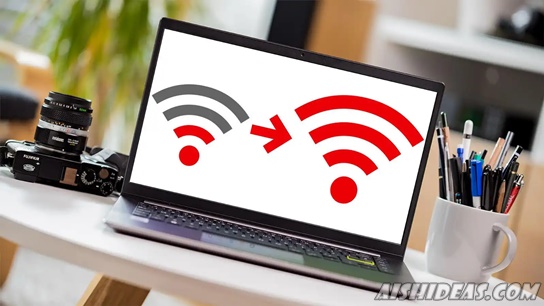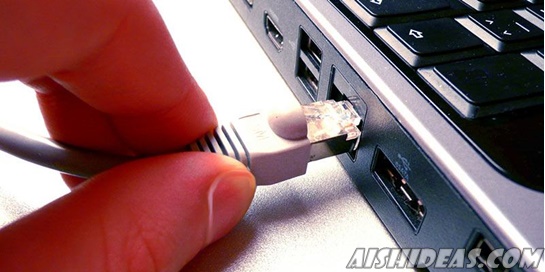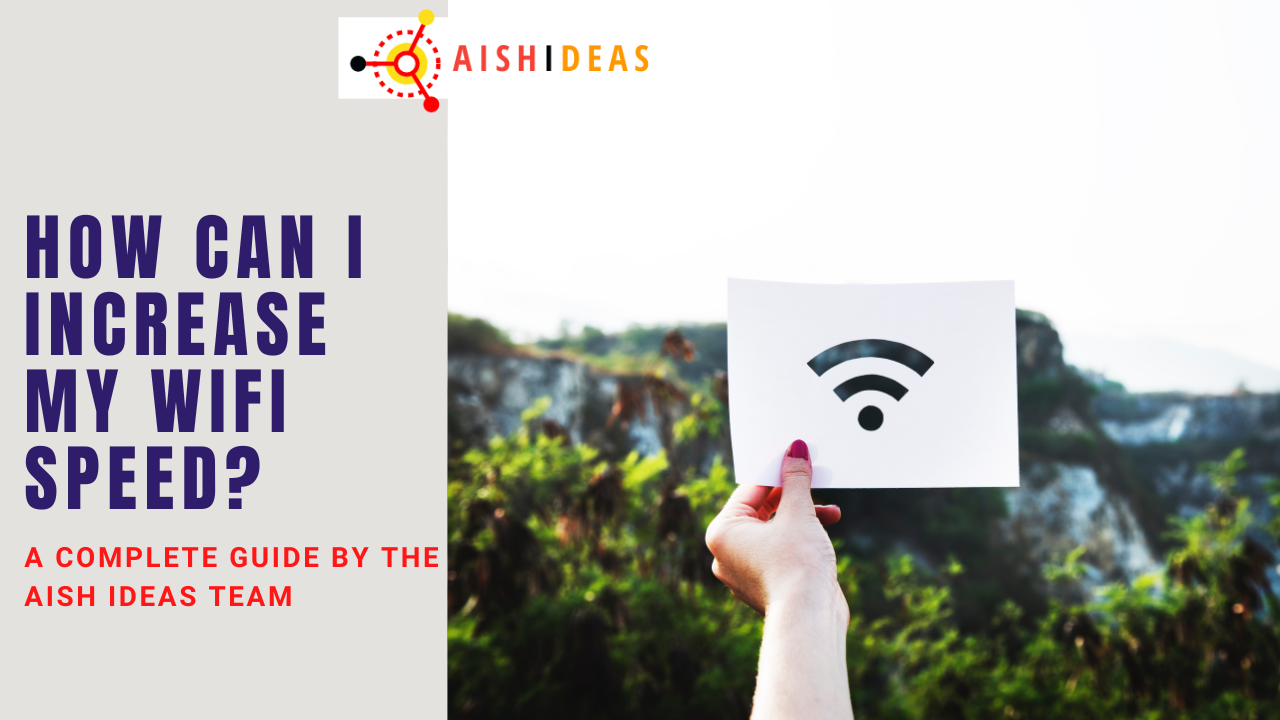Slow Wi-Fi can break video conferences, stop large online worlds, and stop your video stream from buffering. If your world depends greatly on fast-simultaneous connections, these small frustrations will quickly stack up and become an obstruction to your livelihood, school, and everyday activities.
In this article, Aish Ideas will discuss “How Can I Increase My WiFi Speed?” and also “How to test internet speed in easy ways?”
If your home WiFi is feeling a little sluggish, there are some things you can do to give it a speed boost. Many factors can affect your WiFi speed, from the number of devices using the network to the location of your router. But there are a few simple tweaks you can make to improve your WiFi speed.
Contents
- Test Your Internet Speed
- 4 Common Reasons For Slow WiFi Speed
- How Can I Increase My WiFi Speed? 10 Tips
- 1. Check For Interference
- 2. Upgrade Your Equipment
- 3. Use A Wired Connection
- 4. Optimize Your Router
- 5. Change Your Wifi Channel
- 6. Update Your WiFi Driver
- 7. Use A VPN
- 8. Disable Background Programs
- 9. Move Your Router
- 10. Use WPA2 Encryption
- Conclusion
Test Your Internet Speed
One way to test your internet speeds is to use an online speed test. There are many different websites that offer this service, and they will all give you slightly different results.
Fast.com is a popular option, but there are others available as well. Once you go to the website, it will test your download and upload speeds as well as your ping.
Another way to test your internet speed is to use a specific program designed for that purpose. Many of these programs such as the internet speed checker and fast.com are available for free online.
Once you download and install the program, it will run a series of tests and give you an accurate measurement of your current internet speeds.
Finally, you can always contact your internet service provider directly and ask them to run a speed test for you.
4 Common Reasons For Slow WiFi Speed
There are many reasons why your WiFi might be running slow. Here are some of the most common reasons for slow internet speed under discussion:
1. Interference from other devices
If your home WiFi network is slow, it could be due to interference from other devices. Wireless devices such as cordless phones, baby monitors, and microwave ovens can all cause interference with your WiFi signal.
Even if these devices are not in use, they can still emit electromagnetic waves that can disrupt your WiFi signal. To improve your WiFi speed, try to keep these devices away from your router and any other wireless devices.
2. Your router is old or outdated
If you’re using an older router, it might not be able to handle the demands of today’s WiFi devices. Consider upgrading to a newer model.
3. You’re too far from your router
The further you are from your router, the weaker the signal will be. Try moving closer to your router or adding a second one to extend the range.
4. You have too many devices connected to your WiFi
If you have too many devices trying to connect to your WiFi at once, it can cause slow speeds for everyone. Limit the number of devices that are connected or upgrade to a higher-speed plan if possible.
How Can I Increase My WiFi Speed? 10 Tips
There are the following 10 tips that you can do to try and increase your WiFi speed.

1. Check For Interference
If you’re looking to increase your WiFi speed, one thing you can do is check for interference. Interference can come from a variety of sources, including other WiFi networks, Bluetooth devices, microwave ovens, and even baby monitors.
To check for interference, simply open your WiFi router’s settings and look for the ” channel” or “frequency” option. Once you’ve found it, select the channel that has the least amount of activity. You may need to experiment with a few different channels before you find one that works best for you.
Once you’ve selected the optimal channel for your router, be sure to save your changes and reboot your router. You should see an immediate increase in your WiFi speed.
2. Upgrade Your Equipment
If you’re looking to upgrade your equipment to increase your WiFi speed, there are a few things you can do. One is to upgrade your router. A newer, more powerful router will be able to handle more devices and provide a stronger signal.
Another option is to upgrade your modem. This can give you higher speeds and help improve your connection quality. Finally, make sure you have the latest firmware for your devices. This can often provide significant speed increases. If you follow these tips, you should see a noticeable improvement in your WiFi speed.
3. Use A Wired Connection
One way to increase your WiFi speed is to use a wired connection. This will increase the speed of your internet connection and make it more reliable.

Another way to improve your WiFi speed is to make sure that you are using the right router for your needs. If you have a large home or office, you may need a more powerful router than someone who lives in a small apartment.
Finally, you can also try changing the channel that your router is using. This can help to improve your signal and reduce interference from other devices that are using the same frequency.
4. Optimize Your Router
There are a few things you can do to optimize your router and increase your WiFi speed.
One thing you can do is update the firmware on your router. Firmware updates often include performance improvements, so this is a good first step.
Another thing you can do is change the channel that your router broadcasts on. If there are a lot of other WiFi networks in your area, they may be competing for the same channel, which can slow down your connection.
You can use a tool like WiFi Analyzer to see what channels are being used by other networks and choose a less crowded one for yours.
Finally, make sure that your router is in a good location. If it’s hidden away in a cabinet or behind a lot of objects, the signal will be weaker and slower.
5. Change Your Wifi Channel
If your home router is on the 2.4GHz band, there are only three non-overlapping channels to choose from 1, 6, and 11. (channels 2, 3, 4, and 5 overlap with channel 1; channels 7, 8, and 9 overlap with channel 6; and channels 12, and 13 overlap with channel 11). By changing your WiFi channel you can increase your WiFi speed.
If you live in an apartment building or have a lot of interference from other networks in your area (like cordless phones or baby monitors), try using one of the higher-numbered channels (8-11).
If that doesn’t work or if you live in a single-family home with little interference, go ahead and try all three channels to see which one gives you the best performance.
6. Update Your WiFi Driver
If you’re looking for ways to increase your WiFi speed, one of the best things you can do is update your WiFi driver. Out-of-date drivers can cause a number of problems, including reduced speeds and connection issues.

You can usually find the latest drivers for your WiFi adapter on the manufacturer’s website. Once you’ve downloaded and installed the new driver, restart your computer for the changes to take effect.
7. Use A VPN
If you’re looking for ways to increase your WiFi speed, one option is to use a VPN. A VPN can help to encrypt your data and improve your privacy, both of which can lead to faster speeds. Additionally, a VPN can help you bypass internet throttling and improve your connection quality.
8. Disable Background Programs
If you’re looking for ways to increase your WiFi speed, one thing you can try is disabling background programs. This will free up resources on your computer that could be bogging down your connection.
To disable background programs, first, open the Task Manager by pressing Ctrl+Shift+Esc. Then, click the “Processes” tab and look for any programs that are running in the background and taking up a lot of resources. Right-click on these programs and select “End task” to close them.
You may also want to check for any browser extensions or toolbars that could be slowing down your connection. To do this in Chrome, click the menu icon in the top-right corner and select “More tools,” then “Extensions.” Review each extension and disable any that you don’t need.
9. Move Your Router
If your home WiFi network is slow, there are a few steps you can take to try to speed it up. One easy way to improve your WiFi signal is to move your router. If your router is in a central location, moving it closer to the devices that connect to it can help.
If your router is in a corner or behind a piece of furniture, try moving it to a more open area. You can also try raising it up off the ground since routers typically broadcast signals downward.
Another way to speed up your WiFi connection is to change the channel that your router broadcasts on. Most routers come set to channel 6 by default, but sometimes other networks in your area can interfere with this channel and cause a slowdown.
You can usually find instructions for how to change your router’s channel in its user manual or online.
10. Use WPA2 Encryption
Almost everyone has a Wi-Fi connection in their home these days. But, did you know that you can make your Wi-Fi faster by using WPA2 encryption? WPA2 is the most recent and most secure form of Wi-Fi encryption.

It encrypts all traffic on your network so that no one can eavesdrop on what you’re doing. Not only does WPA2 encryption keep your data safe, but it can also increase your Wi-Fi speed.
That’s because WPA2 encrypts your data using AES, which is a very efficient form of encryption. So, if you want to keep your data safe and make your Wi-Fi faster, be sure to use WPA2 encryption.
Conclusion
In conclusion, there are several ways that you can increase your WiFi speed. By changing the channel that your router is using, you can avoid interference from other devices.
You can also try moving your router to a different location in your house, or even add a second router to extend your WiFi range. By following these simple tips, you can ensure that you’re getting the most out of your WiFi connection.
Relevant Guides And Tips
- How to Change Xfinity WiFi Password? [With Easy Steps]
- Full Bars of WiFi But Still No Connection [Tech Guide]
- Sony TV wifi Keeps Turning Off [How To Fix with 8 Solutions]
- LG TV Keeps Disconnecting From WiFi: 8 Tested solutions

